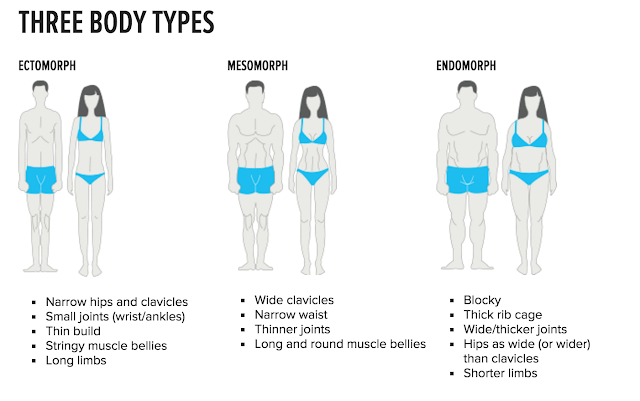In personal trainer training we are taught to describe
people’s body types in three ways.
Ectomorph – Lean and slender build with slight muscular
development.
Mesomorph – Athletic/muscular body build.
Endomorph – Heavy rounded body build with a tendency to
become overweight.
Most people fit into one or two of these categories. Just
because you are in one of these categories does not mean you can’t alter the way
your body looks. But, you defiantly cant go from being a ruler to an hourglass
or vice versa, it just won’t happen due to your genetics, build, your bone
structure, despite what fitness industry marketing claims!
What you can do through exercise is change the size of your
natural shape, as well as increase muscle and bone strength. For example, going
from a large ectomorph to a slimmer toned one or vice versa. Either way the
actual shape of your body will not change. I am telling you this, because I see
so many people embark on a new training programme or coming in and asking
Personal trainers to help them change their bodies. So often I would sit with a
client and ask them their goals, only to be told that they want an hour glass
figure, or a six pack! I am a good trainer, but I can’t out do your genetics,
nobody can.
When fitness programmes or trainers allow people to believe
that they can change their bodies aesthetically, they are setting clients up
for disappointment. Too many people begin exercising purely to change the look
of their bodies, which is why so many lose motivation so quickly. Changing your
body through exercise takes a lot of time and dedication, ask any body builder,
it is a slow and dedicated process that most won’t be able to achieve.
Furthermore, we cannot physiologically change fat to muscle. For example,
although doing lots of repetitions of an exercise creates a feeling of using
this muscle group, it will not burn the fat deposits off the targeted area.
What will occur is that the muscles become stronger and
larger, which may be contrary to what many women may be trying to achieve in
attempting to sculpt leaner-looking physique. No amount of crunches will burn
off abdominal fat directly. Increased physical activity in general, exercise
and good nutrition are key to maintaining a healthy body.
Now, I am defiantly not saying that there is no point
exercising. What I am trying to say is you should change your motives for
exercising. Setting SMART goals will help you stay motivated and will help you
feel more accomplished. For example, when I first started in the gym, I could
not run. So, I set a goal to run for 30 seconds and slowly build this up over
time. The sense of accomplishment I felt when I could finally run for a full 30
minutes and still breathe was amazing. It is the little fitness achievements
like this that keep me going. Hitting a new PB, challenging yourself and
felling fitter and healthier in the long run is really a great way to not only improve
your overall health, but also improve your self-esteem and mental wellbeing. In
addition, much research shows that when you exercise you improve your body
confidence despite any physical changes! More research is needed as to why this
happens, but it is thought that exercising gives you better body awareness and
makes you feel more toned. From what I have learnt so far about body confidence
is that it is all about perception, so it makes sense that exercise can improve
your perception of your body and make you feel better about it.
So, if you are currently training purely to change you
physical appearance, I encourage you to change your goals, believe me it’s for
the greater good.
Tips on exercising healthily:
·
Exercise for
health, not weight loss. Focus on feeling genuinely healthier, rather than on
control and burning calories.
·
Don’t be too
repetitive. Cycling for hours every day at gym, or running on a treadmill can
lead to that control-based mindset. Try different types of exercise rather than
the same thing each session.
·
Make exercise
fun – exercise out of doors, with a friend or by dancing at a club to make
exercise more fun. Toss a balloon at a friend. Take your dog for a walk.
·
Connect with
your body. During eating disorders, we often cut ourselves off from our bodies.
Getting reconnected to your body will help exercise to be more healthy. This
can be scary at first, but it’s an important part of healthy exercise.
·
Don’t push
too hard. Do enough exercise, but not too much. It may take a while to get the
balance right, but over time it should start to fall into place. If you feel
sick, sore or dizzy, then you know you’ve pushed it too far.
·
Do mindful
exercise that helps you connect. Examples are yoga, Pilates and tai chi. All these
focus on the body in a slow and careful way, so that you learn more about how
your body moves and how to move it well.
·
If exercise
starts to feel like it’s moving towards “unhealthy” mode, take some time out
and think about what you really want to gain from exercise, and how you can
approach things in a healthier way.
·
It’s not so
much what you do, as how you do it. It’s about enjoyment, rather than just
about doing the “right” type of exercise. Yoga can be unhealthy too, if you push
yourself too far.


Comments
Post a Comment